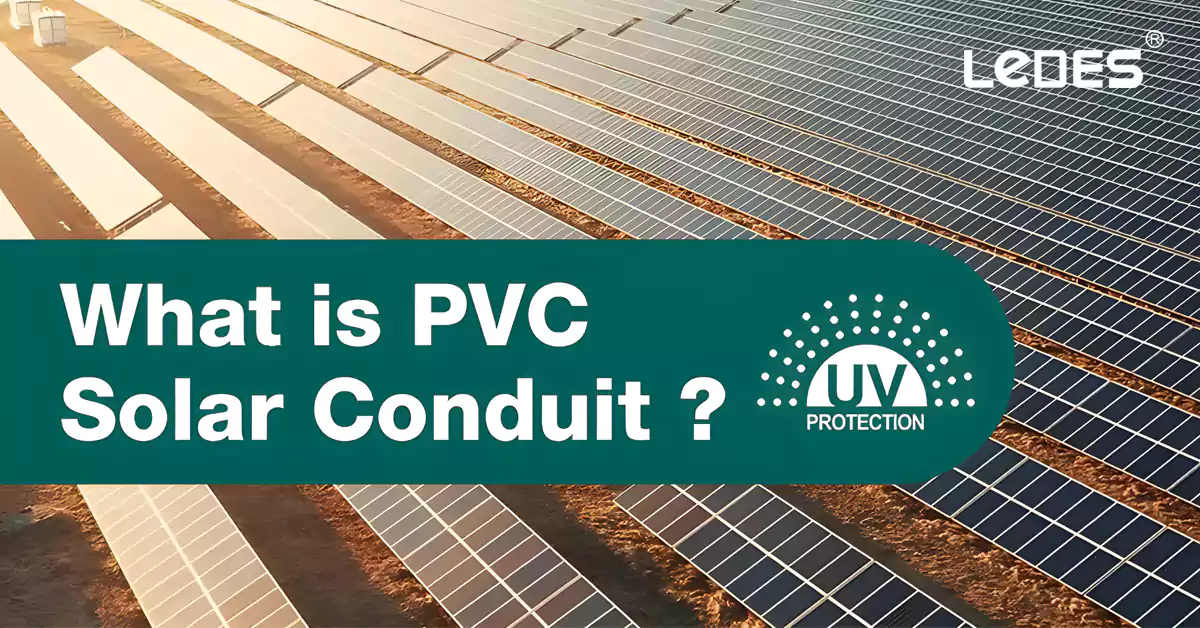
Tabla de contenido
En los últimos años, el rápido crecimiento de la energía solar ha allanado el camino para soluciones innovadoras en el campo de las tuberías eléctricas. A medida que la sociedad moderna se esfuerza por obtener fuentes de energía más limpias y sostenibles, la demanda de instalaciones solares eficientes y fiables se ha disparado. Este artículo pretende arrojar luz sobre el concepto de... Conducto Solar proporcionando una descripción general de los conductos eléctricos y su aplicación específica en sistemas de energía solar.
Los conductos eléctricos sirven como canal de protección para el cableado eléctrico, proporcionando un medio seguro y organizado para el tendido de cables de alimentación y comunicación. Desempeñan un papel vital en la protección de los circuitos eléctricos contra daños físicos, humedad y factores ambientales. Los sistemas de conductos se utilizan comúnmente en entornos residenciales, comerciales e industriales para garantizar la integridad y durabilidad de las instalaciones eléctricas.
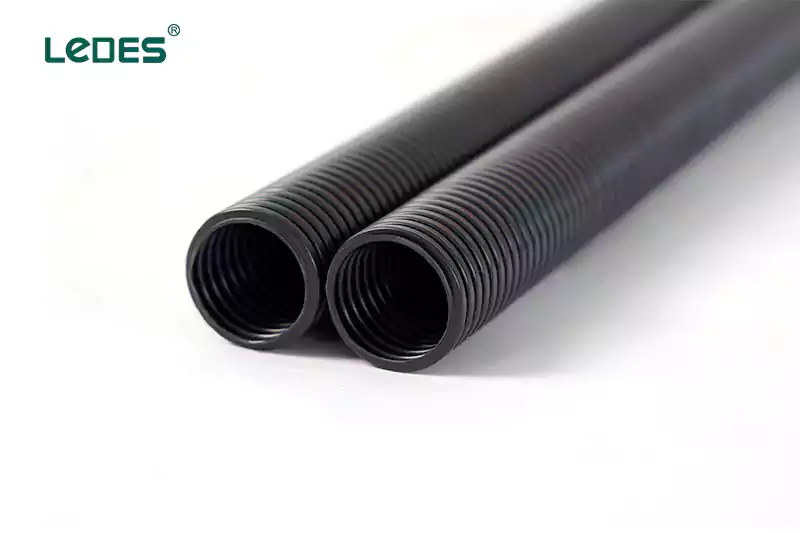
El conducto solar es un tipo de conducto eléctrico especializado, diseñado específicamente para sistemas solares fotovoltaicos (FV). A medida que las instalaciones de energía solar continúan expandiéndose, los requisitos específicos de estos sistemas han llevado al desarrollo de soluciones de conductos adaptadas a sus necesidades.
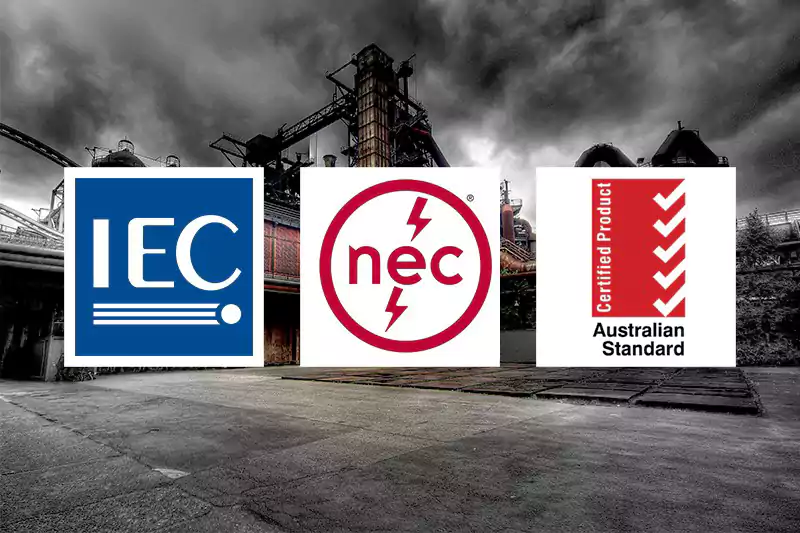
Para garantizar la calidad, la seguridad y el cumplimiento normativo de los conductos solares de PVC, se han establecido diversas normas y requisitos. Estas directrices ayudan a fabricantes, instaladores y organismos reguladores a mantener la uniformidad y la fiabilidad de los sistemas de energía solar.
El NEC es una norma ampliamente reconocida en la industria eléctrica que establece los requisitos para la instalación segura de sistemas eléctricos, incluyendo conductos. Aborda el dimensionamiento, los métodos de instalación y la conexión a tierra de los conductos utilizados en sistemas de energía solar. El cumplimiento de las normas NEC es crucial para garantizar la correcta instalación y el correcto funcionamiento de los... Conducto solar de PVC.
La Comisión Electrotécnica Internacional (IEC) ha desarrollado varias normas relevantes para los conductos eléctricos, incluidas las aplicables al PVC. Conducto para panel solarLa norma IEC 61386-21 proporciona especificaciones para sistemas de conductos rígidos, mientras que la IEC 61386-24 cubre los requisitos para sistemas de conductos flexibles. Estas normas abordan factores como las dimensiones, las propiedades mecánicas y las características de rendimiento de los sistemas de conductos utilizados en diversas aplicaciones, incluidas las instalaciones solares.
Standards Australia (AS) también desempeña un papel importante en el establecimiento de normas para conductos eléctricos. La norma AS 2053 proporciona especificaciones para conductos rígidos y flexibles utilizados en instalaciones eléctricas. Estas normas abarcan aspectos como materiales, dimensiones, resistencia mecánica y resistencia a factores ambientales. La AS 2053 garantiza que los conductos solares de PVC cumplan con los requisitos necesarios de durabilidad y rendimiento en sistemas de energía solar.
Considerando la exposición de las instalaciones solares a la luz solar y la radiación UV, los conductos solares de PVC deben someterse a pruebas UV para evaluar su resistencia a la degradación. Estas pruebas consisten en someter el conducto a una luz solar simulada y monitorear su rendimiento a lo largo del tiempo. Los resultados de las pruebas proporcionan información valiosa sobre la capacidad del conducto para soportar una exposición prolongada a la radiación UV sin una degradación significativa ni pérdida de propiedades.
Los productos de conductos solares Ledes pasaron la prueba de envejecimiento UV de 1080 horas, sin cambios de color evidentes ni degradación de las propiedades.
La seguridad contra incendios es un factor crucial para los sistemas de conductos eléctricos, incluyendo los conductos solares de PVC. Los conductos resistentes al fuego están diseñados para resistir la propagación del fuego y mantener la integridad de los circuitos eléctricos durante un incendio. Las clasificaciones de resistencia al fuego se suelen basar en criterios como la resistencia a las llamas, la generación de humo y la toxicidad. Los conductos solares de PVC deben cumplir con las normas de resistencia al fuego aplicables, como UL 1660 o AS 3013, para garantizar su cumplimiento con los requisitos de seguridad contra incendios.
La instalación de paneles solares suele realizarse en entornos exteriores expuestos, como zonas desérticas, donde la temperatura cambia rápidamente. La exposición prolongada a altas y bajas temperaturas puede provocar que el conducto:
Deformación y agrietamiento: los conductos expuestos pueden volverse vulnerables a sufrir daños y agrietarse fácilmente.
Fragilidad: El conducto puede volverse quebradizo y propenso a romperse bajo tensión física. Degradación del rendimiento: Las temperaturas extremas pueden degradar el rendimiento de los conductos con el tiempo y comprometer su capacidad de protección.
Para estas situaciones, el conducto solar debe estar diseñado para soportar temperaturas extremas. El conducto solar LEDES superó pruebas de temperatura de -15 °C a 105 °C y mantuvo su funcionalidad intacta. No presenta signos de fragilidad ni agrietamiento.
En diferentes regiones, como Norteamérica y Australia, pueden existir variaciones en las normas y requisitos específicos para los conductos solares de PVC. Por ejemplo, en Norteamérica, el Código Eléctrico Nacional (NEC) establece directrices para la instalación de conductos, mientras que las normas UL certifican la seguridad y el rendimiento de los productos eléctricos. En Australia, las Reglas de Cableado (AS/NZS 3000) y las normas AS establecen los requisitos para los sistemas de conductos. La comparación de estas normas regionales permite comprender mejor los diferentes enfoques adoptados para garantizar la calidad y la seguridad de los conductos solares de PVC.
El conducto solar de PVC se utiliza comúnmente en las siguientes aplicaciones:
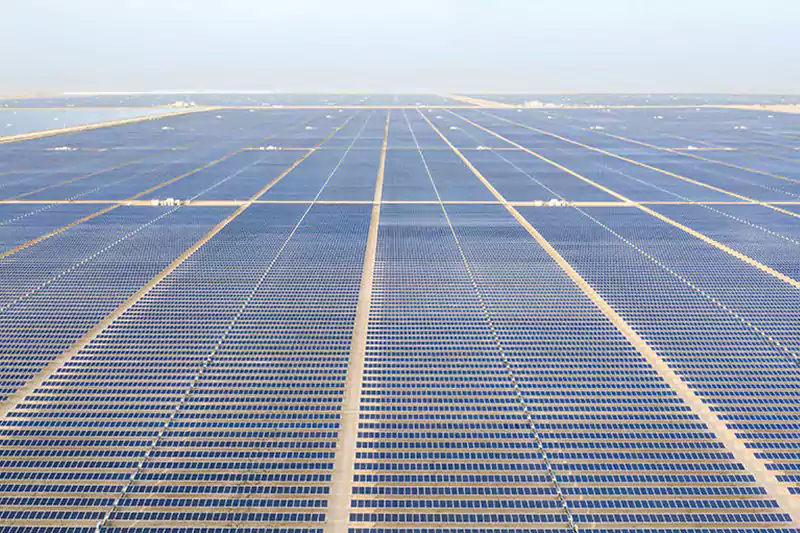
Los proyectos de energía solar fotovoltaica implican la instalación de paneles solares para generar electricidad a partir de la luz solar. Estos proyectos pueden abarcar desde pequeñas instalaciones residenciales hasta grandes parques solares de varias hectáreas.
Los conductos solares Ledes se han utilizado en grandes proyectos fotovoltaicos y han obtenido un gran reconocimiento, como el proyecto ASB de 2,6 GW en Arabia Saudí y el proyecto PV2 en Abu Dabi, que actualmente son los dos proyectos solares fotovoltaicos más grandes del mundo. La aplicación de conductos solares de PVC en proyectos solares fotovoltaicos es crucial para el tendido seguro y eficiente de cables eléctricos.
Un parque solar es una instalación a gran escala compuesta por numerosos paneles solares, a menudo dispuestos en filas o conjuntos, para generar electricidad a escala comercial. Estos parques aprovechan la energía solar y la convierten en electricidad utilizable. Los conductos solares de PVC desempeñan un papel fundamental en la conexión y protección de la extensa red de cables eléctricos dentro de un parque solar. Garantizan el correcto tendido y organización de los cables, manteniendo la integridad y la eficiencia del sistema eléctrico.
Las granjas e instalaciones agrícolas modernas integran cada vez más sistemas de automatización y eléctricos para tareas como el riego automatizado, el control de temperatura y el manejo del ganado. Estos sistemas requieren instalaciones eléctricas fiables y eficientes. Al utilizar sistemas de energía solar limpios y respetuosos con el medio ambiente, los agricultores pueden reducir significativamente los costes y mejorar la eficiencia de la producción. Los conductos solares de PVC y sus accesorios son componentes esenciales en la instalación de sistemas de energía solar en granjas. Proporcionan una ruta segura y organizada para el cableado eléctrico, garantizando la estabilidad y la longevidad del sistema eléctrico.
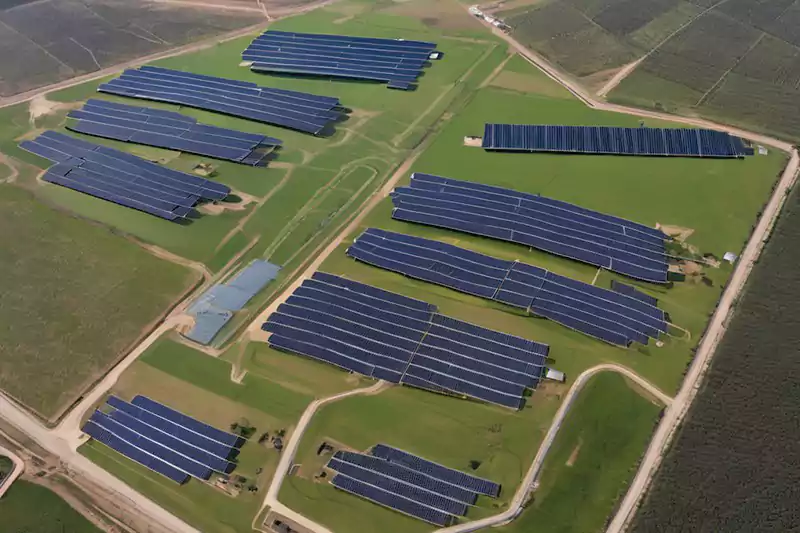
Para las pequeñas instalaciones de procesamiento y fábricas, la incorporación de sistemas de energía solar como fuente de electricidad de respaldo puede ser ventajosa. Los sistemas de energía solar pueden ayudar a reducir la carga en la red eléctrica principal y generar ahorros. En estos casos, la energía solar puede utilizarse para suministrar electricidad a equipos o áreas específicas, como la iluminación, las residencias de los empleados o como energía de respaldo para sistemas críticos como los centros de red. Los conductos solares de PVC son vitales para la instalación y conexión de estos sistemas de energía solar, garantizando una distribución eléctrica confiable y eficiente.
Las perspectivas futuras para Solar Conduit parecen prometedoras a medida que el mundo migra cada vez más hacia fuentes de energía renovables, como la solar. A continuación, se presentan algunos puntos clave y datos de referencia a considerar:
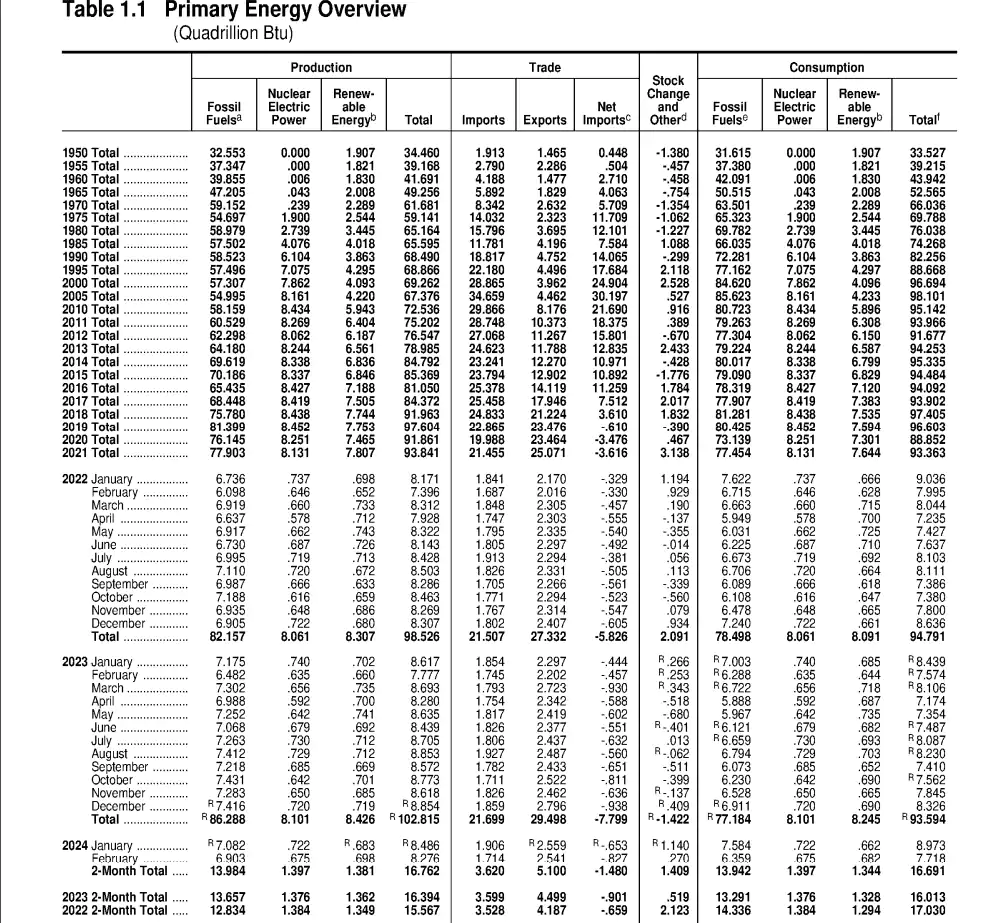
La demanda de energía solar ha ido aumentando de forma constante a nivel mundial. Según datos de la Administración de Servicios Generales de Estados UnidosLas nuevas fuentes de energía, como la energía solar, han ido ganando impulso gradualmente, y las energías renovables experimentaron un crecimiento significativo después de 2022. Esta tendencia indica un cambio hacia opciones energéticas más limpias y sostenibles, incluida la energía solar.
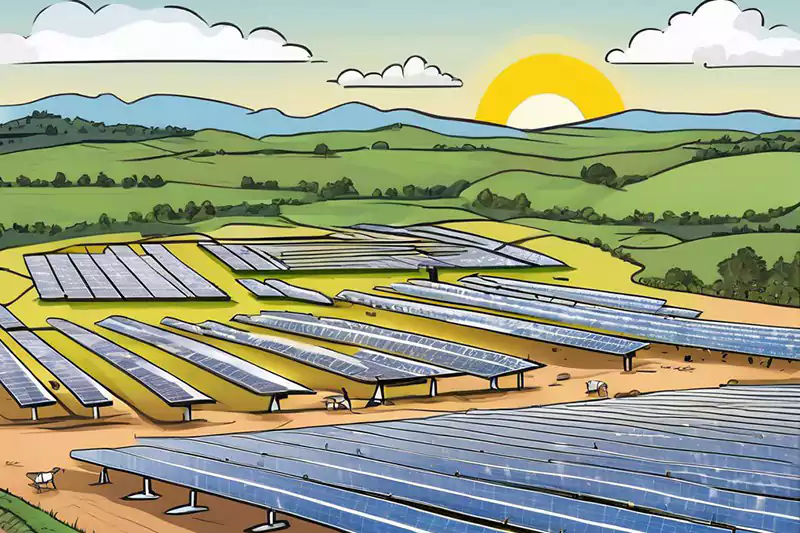
La instalación de paneles solares y sistemas de energía solar está en auge, tanto en el sector residencial como en el comercial. A medida que gobiernos, empresas y particulares buscan reducir su huella de carbono y adoptar las energías renovables, se prevé que la adopción de sistemas de energía solar siga su tendencia ascendente. Este aumento en la actividad de instalación impulsará la demanda de conductos solares de PVC como componente vital de estos sistemas.
Muchos gobiernos de todo el mundo están implementando políticas e incentivos de apoyo para fomentar la adopción de energías renovables, incluida la solar. Estas políticas incluyen tarifas de alimentación, créditos fiscales, subvenciones y otros incentivos financieros. Estas iniciativas crean un entorno favorable para el crecimiento de proyectos de energía solar, lo que, a su vez, impulsa la demanda de conductos solares de PVC.
Los avances continuos en la tecnología solar, incluyendo mejoras en la eficiencia y la asequibilidad de los paneles solares, están haciendo que la energía solar sea más accesible y económicamente viable. A medida que la tecnología solar continúa evolucionando, se espera que la demanda de conductos solares de PVC crezca a la par para satisfacer las necesidades de instalación de sistemas solares avanzados.
La creciente conciencia ambiental y la preocupación por el cambio climático impulsan la transición a fuentes de energía renovables. La energía solar se considera una de las formas de energía más limpias y sostenibles, ya que no produce emisiones de gases de efecto invernadero durante su funcionamiento. El uso de Solar Conduit se alinea con el objetivo de crear sistemas de energía solar respetuosos con el medio ambiente, contribuyendo así al crecimiento de la industria.
Los conductos solares desempeñan un papel crucial en la protección y seguridad de los cables eléctricos en los sistemas de energía solar. Su uso garantiza la transmisión segura y eficiente de la electricidad generada por paneles solares. Con los continuos avances tecnológicos y la creciente preferencia de los consumidores por soluciones energéticas sostenibles, se prevé un crecimiento sustancial de la demanda de conductos solares de PVC.
Existen diversos tipos de conductos utilizados en aplicaciones de energía solar. Estos conductos se pueden clasificar en dos categorías principales según su composición: conductos metálicos y conductos no metálicos.
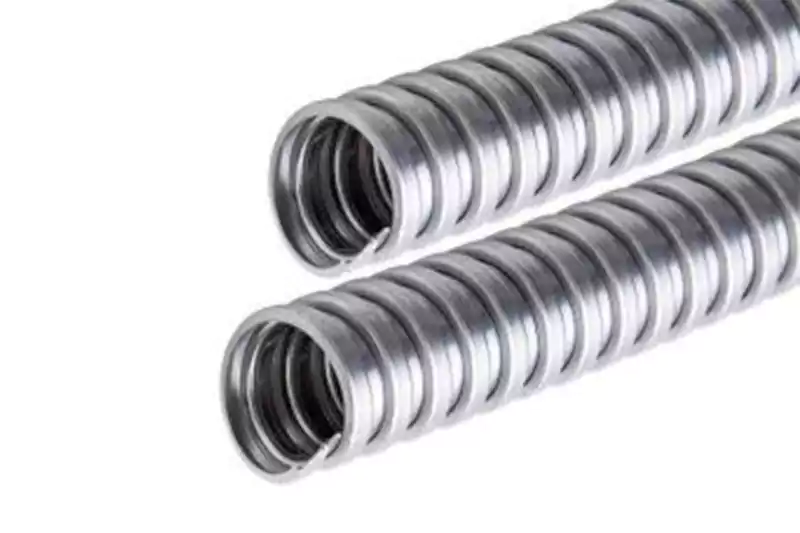
También conocido como conducto de pared delgada, el EMT está hecho de acero galvanizado y se utiliza comúnmente para aplicaciones residenciales y comerciales ligeras.
– Ventajas: Ligero, fácil de doblar e instalar, rentable, buena resistencia a la corrosión.
– Desventajas: Menor protección física en comparación con los conductos rígidos, no apto para entornos hostiles.
Fabricado en acero galvanizado de paredes gruesas, RMC proporciona un alto nivel de protección física para el cableado eléctrico en aplicaciones más exigentes.
– Ventajas: Proporciona excelente protección física, adecuado para entornos exigentes, alta durabilidad.
– Desventajas: Pesado y rígido, más difícil de instalar en comparación con otros conductos, mayor costo.
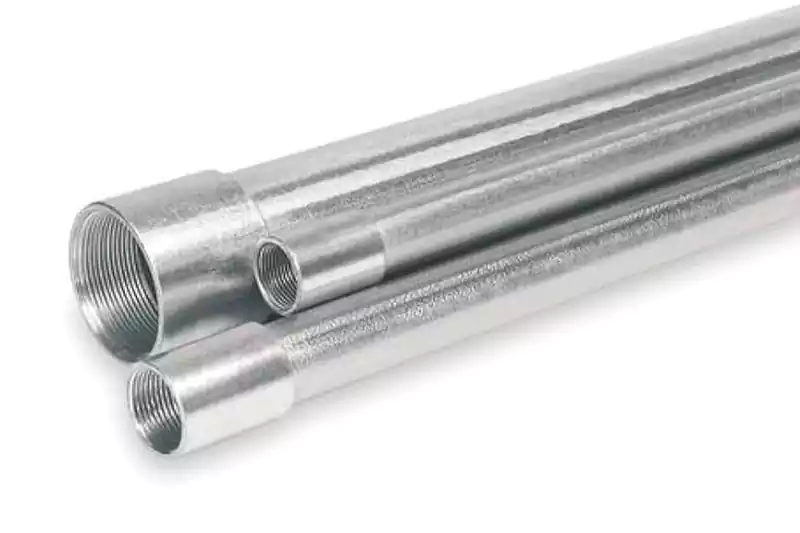
Similar al RMC, el GRC es un conducto de paredes más gruesas hecho de acero galvanizado y se utiliza comúnmente en entornos industriales y comerciales.
– Ventajas: Ofrece protección superior en lugares peligrosos, alta resistencia, excelente resistencia a la corrosión.
– Desventajas: Pesado y rígido, más caro que otros conductos metálicos.
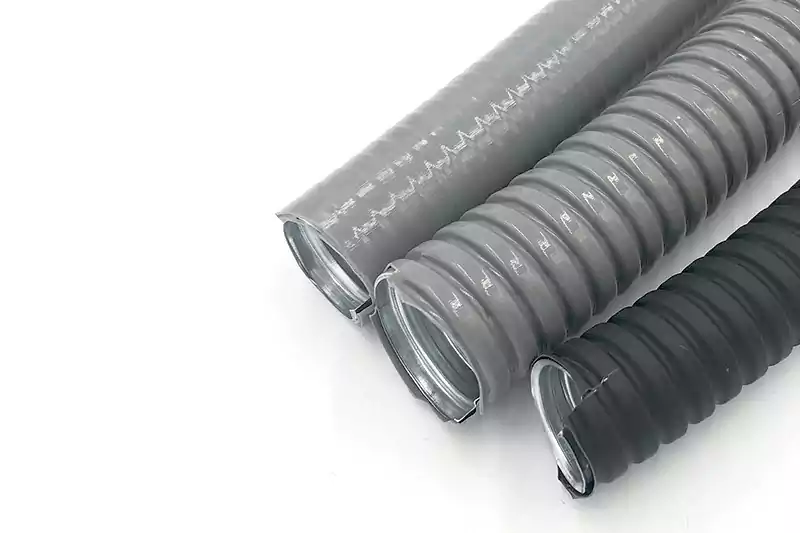
Este conducto consta de un núcleo metálico flexible y una cubierta exterior hermética a los líquidos, lo que proporciona protección en entornos donde la humedad o la exposición a líquidos son una preocupación.
– Ventajas: Flexibilidad para una fácil instalación en espacios reducidos, proporciona protección hermética a los líquidos, adecuado para exteriores y lugares húmedos.
– Desventajas: Protección mecánica limitada en comparación con los conductos rígidos, mayor coste en comparación con los conductos no metálicos.
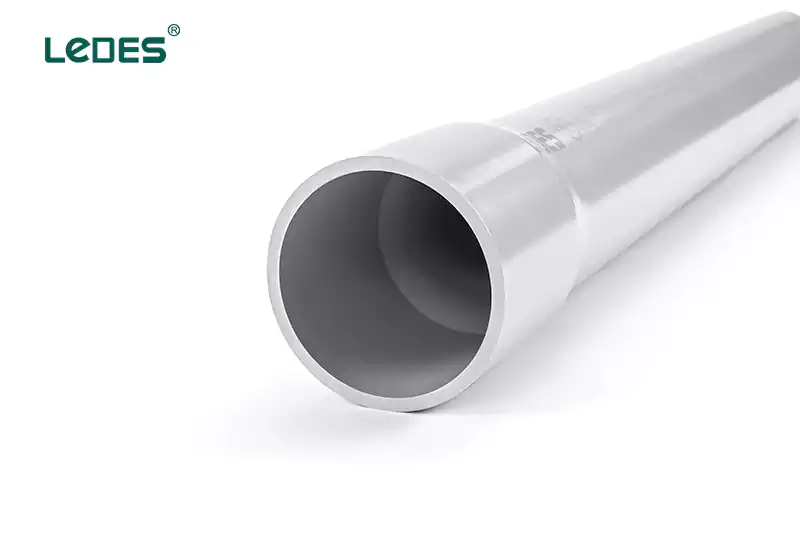
El conducto de PVC (cloruro de polivinilo) es una opción popular para instalaciones eléctricas debido a su durabilidad, precio asequible y resistencia a la corrosión. Está disponible en varios tamaños y se utiliza comúnmente tanto en aplicaciones residenciales como comerciales.
– Ventajas: Ligero, de bajo costo, resistente a la corrosión, fácil de instalar, disponible en varios tamaños y longitudes.
– Desventajas: Menor resistencia al impacto en comparación con los conductos metálicos, puede degradarse bajo exposición prolongada a la luz solar.
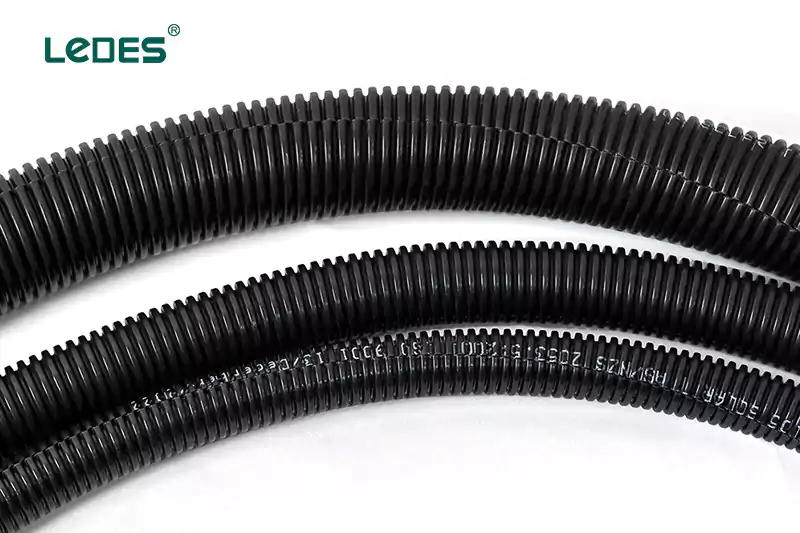
El ENT es un conducto flexible, no metálico, generalmente fabricado con PVC o una mezcla de PVC y nailon. Se utiliza comúnmente en aplicaciones residenciales y comerciales ligeras debido a su fácil instalación.
– Ventajas: Flexible y fácil de instalar, resistente a la corrosión y la humedad, adecuado para aplicaciones residenciales.
– Desventajas: Menor protección mecánica en comparación con los conductos rígidos, tolerancia de temperatura limitada.
El LFNC, también conocido como conducto de PVC estanco, es un conducto flexible con una cubierta exterior estanca. Se utiliza comúnmente en exteriores y lugares húmedos donde se requiere protección contra la humedad y los líquidos.
– Ventajas: Proporciona protección flexible y hermética a los líquidos, adecuada para exteriores y lugares húmedos, resistente a la corrosión.
– Desventajas: Protección mecánica limitada en comparación con los conductos rígidos, mayor coste en comparación con los conductos de PVC.
El conducto de HDPE (polietileno de alta densidad) es un conducto no metálico duradero y flexible, comúnmente utilizado en instalaciones subterráneas. Ofrece una excelente resistencia a los productos químicos, la exposición a los rayos UV y las agresiones ambientales.
– Ventajas: Durable y flexible, excelente resistencia a productos químicos y a la exposición a los rayos UV, adecuado para instalaciones subterráneas.
– Desventajas: Protección mecánica limitada en comparación con los conductos metálicos, mayor coste en comparación con los conductos de PVC.
El conducto solar es crucial para los sistemas de energía solar debido a las siguientes razones:
Los conductos solares proporcionan una protección esencial para los cables y el cableado eléctrico en instalaciones solares, protegiéndolos de daños físicos, factores ambientales, humedad, radiación UV y plagas. Esta protección garantiza la fiabilidad y seguridad del sistema a largo plazo.
Los conductos solares ayudan a cumplir con el código eléctrico y los requisitos de seguridad específicos de las instalaciones solares. Garantizan una gestión adecuada del cableado, la conexión a tierra y el aislamiento, lo que reduce el riesgo de peligros eléctricos y garantiza el cumplimiento de las normativas y estándares locales.
El conducto solar está diseñado para soportar las duras condiciones exteriores típicas de las instalaciones solares. Está fabricado para resistir temperaturas extremas, humedad, exposición a la luz solar y productos químicos, lo que garantiza un rendimiento duradero y minimiza la necesidad de mantenimiento.
Los conductos solares permiten un cableado ordenado y ordenado dentro del sistema de energía solar. Facilitan el enrutamiento y la gestión de los cables eléctricos, reduciendo el riesgo de enredos, interferencias y daños accidentales. Una organización adecuada simplifica el mantenimiento del sistema, la resolución de problemas y futuras ampliaciones o actualizaciones.
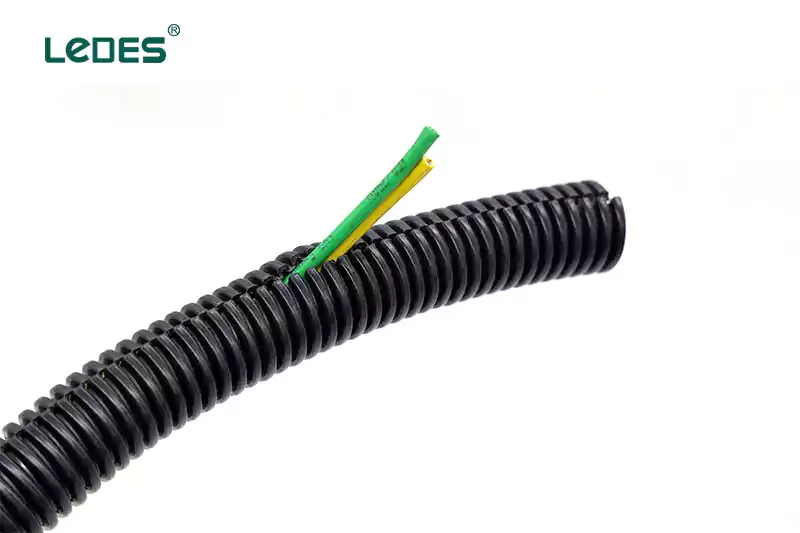
Rentable: Los conductos de PVC generalmente son menos costosos en comparación con los conductos metálicos, lo que los convierte en una opción rentable para instalaciones solares.
Fácil instalación: El conducto de PVC es liviano y fácil de manipular, lo que simplifica los procesos de transporte e instalación.
Seguridad: El PVC proporciona un aislamiento eléctrico confiable, garantizando un sistema eléctrico seguro dentro de la instalación solar.
Resistencia a la corrosión: el PVC es inherentemente resistente a la corrosión y es adecuado para diversas condiciones ambientales.
Protección superior: Los conductos metálicos ofrecen una excelente protección física para el cableado eléctrico en entornos exigentes y ubicaciones peligrosas.
Durabilidad: Los conductos metálicos tienen alta durabilidad y resistencia, proporcionando un rendimiento duradero y protección contra daños físicos y factores externos.
Mayor costo: Los conductos metálicos generalmente son más caros en comparación con los conductos de PVC.
Instalación difícil: Los conductos metálicos son más pesados y rígidos, lo que hace que sea más difícil instalarlos en comparación con los conductos de PVC.
Los accesorios son esenciales en las instalaciones eléctricas, aquí se muestran algunos accesorios de uso común que ofrece Ledes:
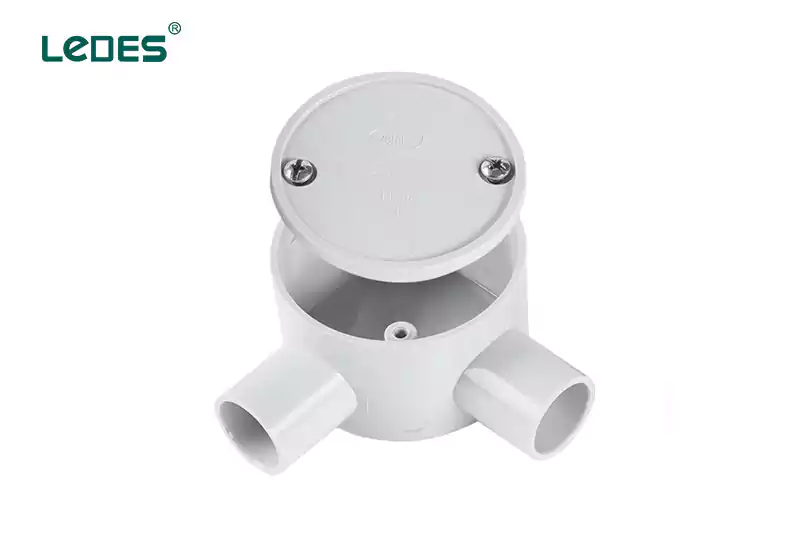
Las cajas de conexiones son cajas eléctricas que se utilizan para proteger y conectar cables eléctricos. Ofrecen un espacio seguro y organizado para empalmar cables y realizar conexiones.
Los codos de barrido, también conocidos como curvas de barrido, son accesorios curvos para conductos que se utilizan para cambiar la dirección del tendido de un conducto con suavidad. Tienen un radio mayor que los codos estándar, lo que ayuda a reducir el riesgo de dañar o doblar los cables dentro del conducto durante el doblado.
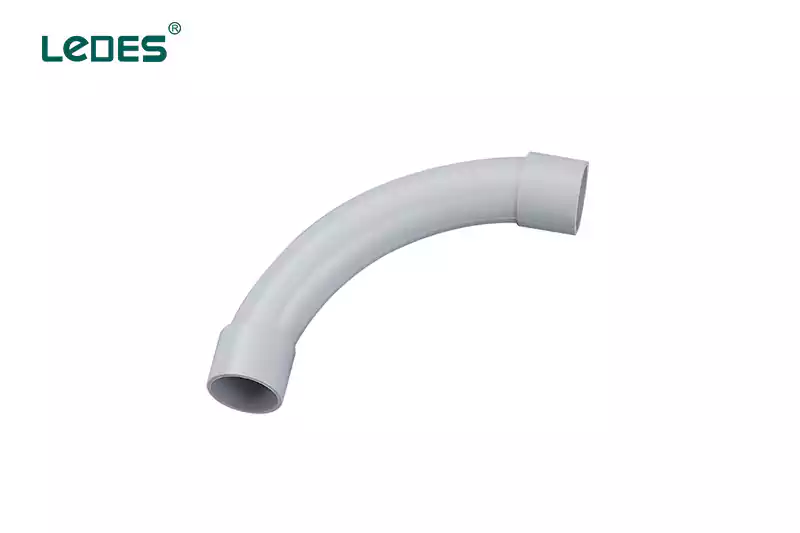
Los codos estándar, también conocidos como codos rígidos, son accesorios para conductos que se utilizan para cambiar la dirección de un conducto en 90 grados. Se utilizan comúnmente en instalaciones eléctricas para sortear esquinas u obstáculos, manteniendo la alineación y protección adecuadas del cableado eléctrico.
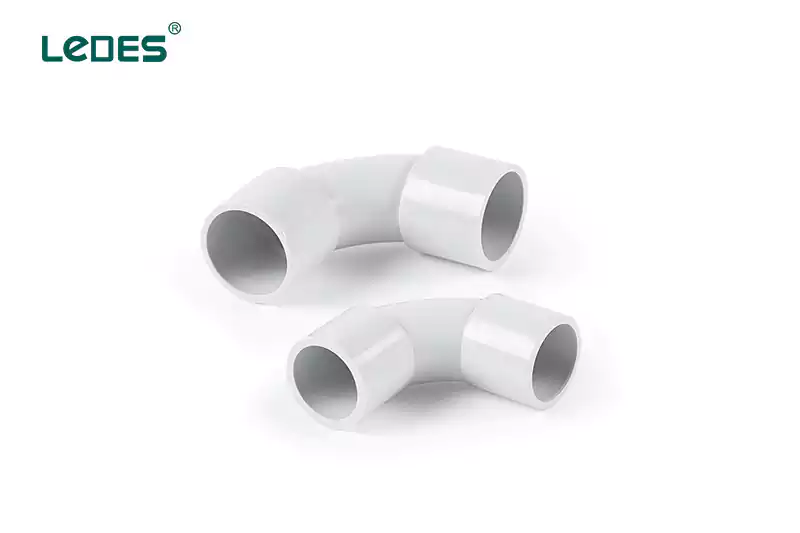
Los codos sólidos son accesorios estándar para conductos que permiten un cambio de ángulo de 90 grados u otro especificado en la dirección del conducto. Se utilizan a menudo para sortear esquinas u obstáculos, manteniendo la integridad y protección del cableado eléctrico.
Los codos de 90 grados son un tipo específico de codo sólido que permite un cambio de dirección en ángulo recto en el tendido de un conducto. Se utilizan ampliamente en instalaciones eléctricas para realizar giros bruscos o conectar secciones de conducto en dirección perpendicular.
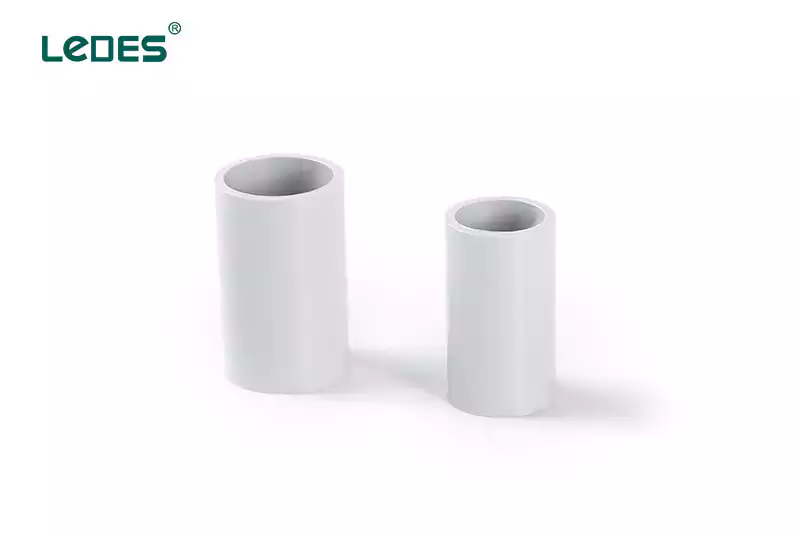
Los acoplamientos son conectores que se utilizan para unir dos secciones de conducto. Se suelen usar al extender o reparar tramos de conductos, lo que permite una ruta segura y continua para el cableado eléctrico.
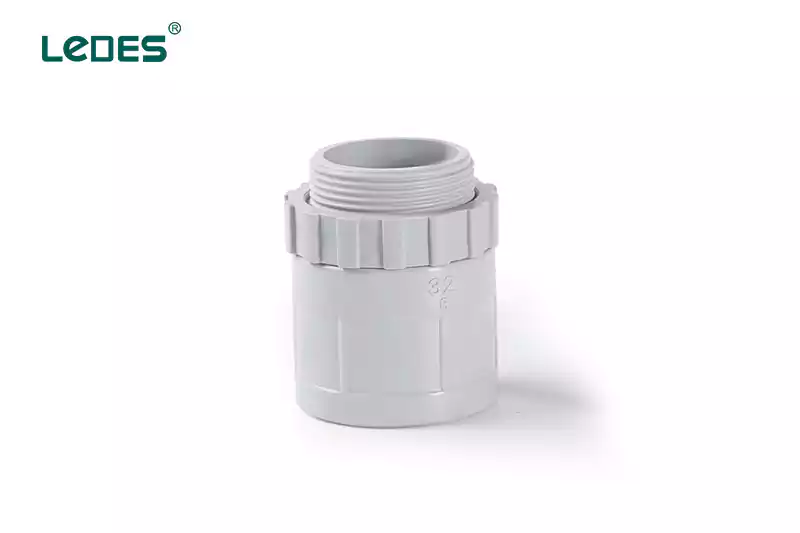
Los adaptadores se utilizan para conectar conductos rígidos o corrugados con cajas eléctricas, como cajas adaptables o cajas de interruptores.
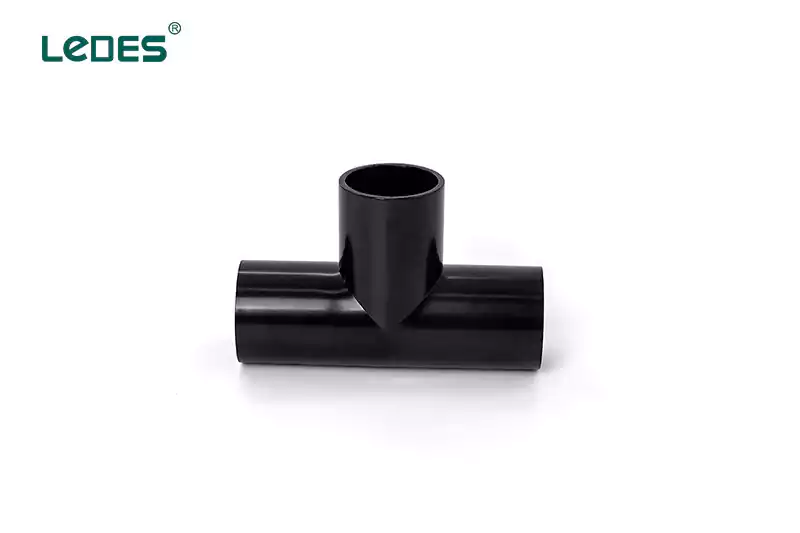
Una te recta es un accesorio de conducto que permite la conexión de una derivación en un tramo de conducto. Tiene tres aberturas: una sirve como ruta principal del conducto y las otras dos sirven para conectar secciones o dispositivos adicionales.
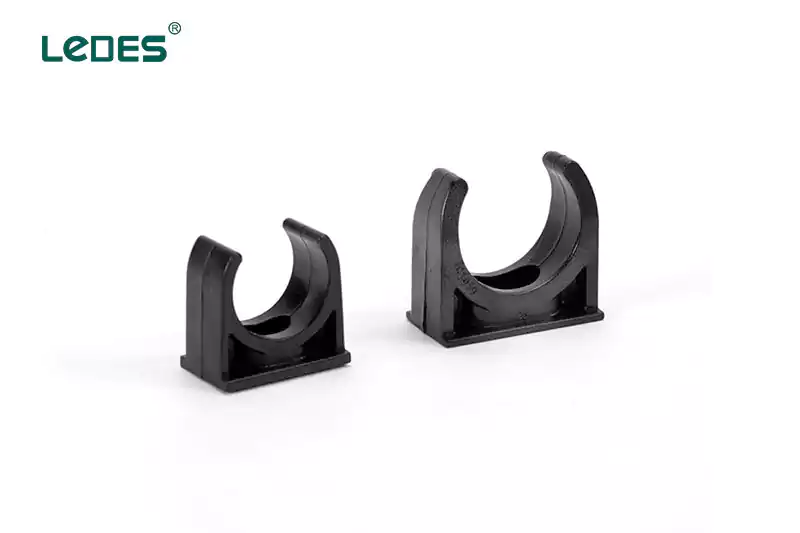
Las abrazaderas en U, también conocidas como abrazaderas para conductos o abrazaderas para conductos, son dispositivos de sujeción que se utilizan para asegurar conductos a superficies como paredes, techos o vigas. Ayudan a mantener los conductos en su lugar y evitan que se deformen o se muevan, garantizando así un soporte y una protección adecuados para el cableado eléctrico.
El mantenimiento adecuado y regular de los conductos solares puede prolongar su vida útil y garantizar la seguridad del sistema eléctrico solar. A continuación, se ofrecen algunos consejos y pasos para un correcto mantenimiento de los conductos:
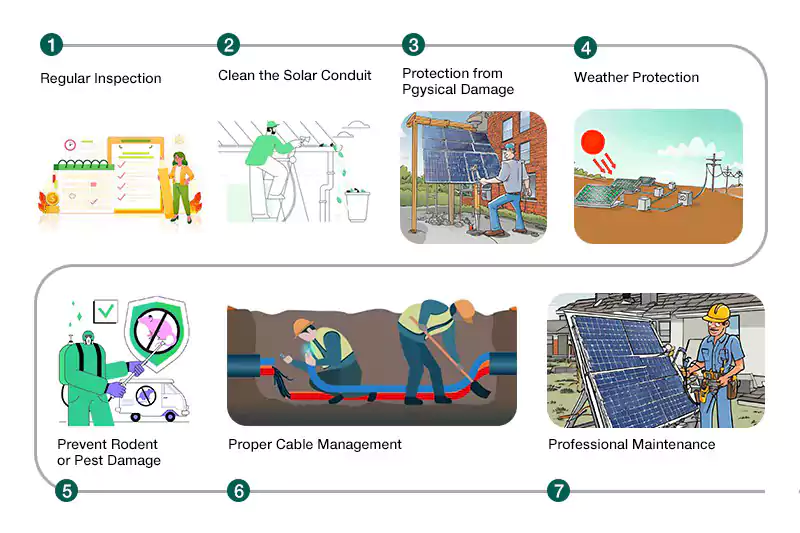
Realice inspecciones periódicas del conducto solar de PVC para identificar cualquier signo de daño, desgaste o deterioro. Busque grietas, roturas, combas o accesorios sueltos. Aborde cualquier problema de inmediato para evitar más daños o posibles peligros eléctricos.
Mantenga limpio el conducto solar de PVC eliminando la suciedad, el polvo o los residuos que puedan acumularse sobre él o a su alrededor. Utilice un paño suave o un cepillo para limpiar suavemente la superficie. Evite utilizar materiales abrasivos o productos químicos fuertes que puedan dañar el PVC.
Tome precauciones para proteger el conducto solar de PVC contra daños físicos. Evite colocar objetos pesados o aplicar una presión excesiva sobre el conducto. Manténgalo alejado de objetos afilados o posibles peligros de impacto.
Los conductos de PVC están diseñados para soportar diversas condiciones climáticas, pero una protección adicional puede ayudar a prolongar su vida útil. Aplique una pintura o revestimiento resistente a los rayos UV para proteger el conducto de la exposición prolongada a la luz solar. Además, asegúrese de que el conducto esté debidamente sellado para evitar la entrada de agua durante lluvias intensas o tormentas.
Compruebe si hay señales de actividad de roedores o plagas cerca del conducto solar de PVC. Los roedores pueden morder el conducto y dañar el cableado interior. Tome las medidas necesarias para evitar el acceso o utilice métodos para disuadir a los roedores si es necesario.
Asegúrese de que los cables o alambres dentro del conducto solar de PVC estén organizados y asegurados correctamente. Evite doblar o sobrecargar excesivamente el conducto, ya que puede provocar daños o un rendimiento deficiente. Utilice técnicas adecuadas de gestión de cables para mantener un sistema ordenado y organizado.
Si detecta daños importantes o sospecha que hay algún problema eléctrico, es recomendable consultar a un electricista o profesional calificado para que evalúe y repare el problema. Ellos pueden brindarle orientación experta, realizar inspecciones exhaustivas y garantizar el mantenimiento y la seguridad adecuados del conducto solar de PVC.
Si sigue estas prácticas de mantenimiento, podrá ayudar a prolongar la vida útil y garantizar el rendimiento óptimo de los conductos solares de PVC en su sistema de energía solar. Las inspecciones periódicas y las reparaciones oportunas son fundamentales para mantener la integridad y la seguridad de los conductos y el cableado eléctrico que se encuentra en su interior.

Al seleccionar una proveedor de conductos solaresEs importante considerar varios factores para elegir el adecuado. Aquí tienes algunas pautas para ayudarte a tomar una decisión informada:
Busque un proveedor de conductos solares que ofrezca productos de alta calidad fabricados de acuerdo con los estándares de la industria, como las certificaciones UL (Underwriters Laboratories) o CSA (Canadian Standards Association). Los productos de calidad garantizan durabilidad, confiabilidad y cumplimiento de los requisitos de seguridad.
Tenga en cuenta la gama de productos del proveedor y si ofrece una variedad de tamaños, tipos y accesorios de conductos para satisfacer los requisitos específicos de su proyecto. Un proveedor con una gama completa de productos puede brindarle flexibilidad y opciones para satisfacer sus necesidades de instalación.
Evalúe los materiales utilizados en los conductos solares que ofrece el proveedor. El PVC (cloruro de polivinilo) es un material común debido a su durabilidad y resistencia a los rayos UV. Asegúrese de que los conductos del proveedor estén diseñados para soportar condiciones exteriores y tengan la protección UV adecuada para evitar la degradación con el tiempo.
Investigue la reputación y el historial del proveedor en la industria. Busque reseñas, testimonios o referencias de otros clientes para evaluar su confiabilidad, servicio al cliente y calidad del producto. Un proveedor confiable con comentarios positivos tiene más probabilidades de brindar productos y asistencia satisfactorios.
Infórmese sobre la política de garantía y los servicios de atención al cliente del proveedor. Un proveedor confiable debe ofrecer garantías que cubran defectos o fallas en sus productos. Además, debe brindar atención al cliente receptiva para consultas, asistencia técnica y servicio posventa.
tetur elit adipiscente. Ut elit tellus, luctus nec ullamcorper mattis, pulvinar dapibus leo.
Compare los precios de distintos proveedores teniendo en cuenta el valor general que ofrecen. No se centre únicamente en el precio más bajo; evalúe la calidad, la fiabilidad y el soporte que ofrece el proveedor. Elegir un proveedor que ofrezca un equilibrio entre precio competitivo y valor puede garantizar una solución rentable y fiable.
Considere el servicio posventa y las ofertas de soporte del proveedor. Un proveedor confiable debe brindar un excelente servicio al cliente, asistencia técnica y una respuesta rápida a las consultas o problemas que puedan surgir durante o después del proceso de instalación. Busque proveedores que tengan un equipo de soporte dedicado y canales de comunicación claros para garantizar una experiencia fluida y eficiente.
Los conductos solares son componentes vitales en la industria de la energía renovable, en particular en los sistemas de energía solar. Cumplen el propósito esencial de alojar y proteger de forma segura el cableado eléctrico en las instalaciones solares. A medida que el mundo se centra cada vez más en el desarrollo y la importancia de las fuentes de energía renovables, como la energía solar y eólica, la demanda de conductos solares ha crecido significativamente.
A medida que el sector de la energía renovable continúa expandiéndose, con una mayor inversión y atención por parte de individuos, empresas y gobiernos de todo el mundo, el uso de energía solar y otras formas de energía limpia está en aumento. En consecuencia, el uso de conductos solares se ha vuelto cada vez más frecuente e importante para facilitar el crecimiento y el éxito de los sistemas de energía solar.
Si tiene algún requisito o pregunta sobre los conductos solares, no dude en contactarnos. Envía el formulario o Envíanos un correo electrónico, Estamos aquí para ayudarle.




